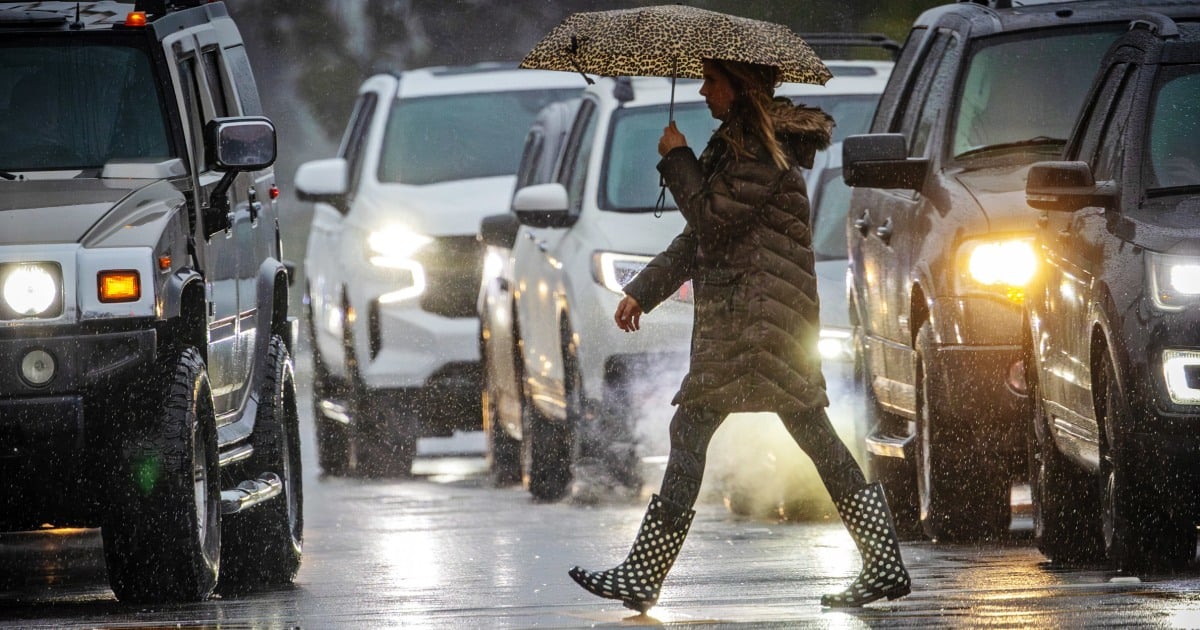The Transportation Department projects the new rule could save 360 lives a year and prevent 24,000 injuries.
The Biden administration plans to require that all new cars and trucks come with pedestrian-collision avoidance systems that include automatic emergency braking technology by the end of the decade.
In an interview, Transportation Secretary Pete Buttigieg said the requirement is designed to reduce pedestrian deaths, which have been on the rise in the post-Covid 19 era.
…
The new standards will require all cars to avoid contact at up to 62 mph and mandate that they must be able to detect pedestrians in the dark. They will also require braking at up to 45 mph when a pedestrian is detected.
The Transportation Department projects the rule could save 360 lives a year and prevent 24,000 injuries.
Or we could regulate vehicle size and reduce speed limits, two things actually proven to reduce pedestrian fatalities and that could be implemented today without waiting on future technological advancements
¯\_ (ツ)_/¯
Speed limits suck at slowing people down. It’s much more effective to change the size and shape of roads. Slimmer roads, with roundabout’s and more pedestrian right of ways slow down cars.
They just made a 6 lane road that goes through commercial strip mall type area 30km/h when it used to be 50km/h. It’s for like 4 blocks with 50km/h on either side. Lights at all intersections.
NO ONE goes 30km/h there, it’s the most insane thing ever.
Side streets with no speed limits (which here makes it 50km/h) thats usually way too fast and most people will naturally go slower than 50 but not gonna lie, 30km/h on some of those also seems excessive.
Add some speed bumps, narrow the street by adding side walks on both sides, and suddenly 30 feels fine.
Tell that to drivers in the Netherlands lol, holy fuck those guys love to haul ass down twisty 2 lane roads that are only 1.75 lanes wide. Still don’t understand how I never lost a side view mirror driving over there.
Don’t even need to reduce size - just reduce hood height (especially when it is unused space for “aesthetics”)
And the technology sucks. I bought a new Subaru last year that has the auto-braking, it activated twice when it didn’t need to at all so I shut it off every time because it’s a fucking hazard.
Seems like you’re unlucky. Subaru’s system is generally considered one of the best in the industry, routinely outperforming the competition.
Separate question, but what model and year? I’m considering a new forester to replace my 2010 Hyundai Santa Fe.
My coworker has a '19 or '20 Legacy and complained about this same thing. He said it’s activated when speeding up behind a vehicle to pass it, cutting power just as he’s about to change lanes to go around.
Yikes. That sounds dangerous! If this is allowed to be deactivated then I would do that.
Sounds like that driver could be like all the other angry “i gotta be in people’s assholes” drivers that are out and about these days. I have a 2024 Solterra and it doesn’t do anything that is being described, however I also leave plenty of space between me and the person in front of me.
Seems the system could be working as intended ¯\_(ツ)_/¯ but they can all be disabled.
I’ve got a '19 Crosstrek and no issues here either. Yes occasionally the warning beeps at me. Usually it’s someone in front of me slowing down for a turn. From my experience, I know they’ll finish making the turn before I reach them and I don’t need to slow down. The system sees a car stopping in front of me and rightfully flashes the red light and beeps. I’ve never had it actually hit the brakes for me but then again, I try to leave plenty of space between me and other cars. My guess is this guy is speeding up to pass but getting way too close to the car in front of him to do it.
deleted by creator
Tesla seems to have pretty good autobreak technology. Like, the brake pedal in the Cyber Truck breaks off by itself.
That’s handy when the accelerators stuck to the bottom of the floor.
Both of them? No wonder they had to recall.
deleted by creator
10/10, have a beaver 🦫
If it’s radar based it should be very reliable. The big issue is camera based stuff. Cameras can’t measure much, only colour and brightness. From this everything is inferred not measured. Inferring things isn’t inherently bad, but the errors need to be accurately known and considered. They probably are, it’s just they are not weighted correctly relative to cost.
Radar doesn’t work for stopped vehicles at high speeds though. You’ll still need cameras and or lidar. OEMs rely so heavily on radar though that their cameras don’t detect this well enough in emergency situations either.
You need either an impeccable vision algorithm, or lidar for this scenario.
That recent Blue Cruise crash for example, even if the conditions had been perfect, and not at night, with no lights, that’s a failure condition for the system. A vehicle moving out of the way of a stopped vehicle ahead of it, is a failure condition on all existing L2 systems. In this case for the human, it’s also a failure condition given the specific conditions.
This is an actual area we can improve on in terms of mandated safety features, solving this problem. There are tons of rear ending of stopped vehicles at high speeds. It’s very dangerous for police/emergency services doing stops, or broken down vehicles. If the vehicle could react to this even when a L2 system isn’t engaged, that would be big.
If it was lidar based it doesn’t even need to be a lidar capable of semi-autonomous driving features, it could be a narrow forward facing one simply for this purpose in emergency situations.
It seems pointless to argue with these people because it seems they’ve convinced themselves that they know exactly how to construct an infallible or nearly infallible autonomous system even though actual experts with billions of dollars at their disposal have yet to create one.
Two cameras can measure distance as well. It’s how our eyes work and how things like 3D scanners work.
You misunderstand. Two cameras can infer distance, they do not and cannot measure it.
Two cameras can produce more accurate and reliable distance results than one. But they still cannot measure distance only infer it.
For certain lighting conditions this can be very reliable like 3D scanners. But cars operate in a staggering range of lighting conditions, with a large variety of environments and materials.
They absolutely can calculate distance as it’s the same principle that allows us to measure the distance of distant planets and galaxies using parallax and trigonometry. Furthermore, if you’re in conditions where cameras can’t see anything, then your car shouldn’t even be on the road as your eyes certainly won’t be able to see anything. Cameras aren’t limited to visible light frequencies like the human eye and my security cameras, for example, can see very clearly in pitch black, low light, or bright light conditions.
You misunderstand. I never said they can calculate distance. They just don’t measure it, it’s inferred. Inferring results in unreliable estimates. The unreliability of which is not accounted for appropriately in camera based autonomy systems.
It’s not an issue in astronomy. Because people can examine the results further and discount any clearly incorrect distance calculations.
It’s not just about not seeing anything. Outdoors is one of the most variable and challenging lighting conditions for most systems. Too much light, shadows, etc.
You only need one frequency of light for camera based distance measurements. They require features rather than a specific light.
Your security camera does not operate in pitch black. It has infra red lights that illuminated the scene, you just can see it. Your security cameras are subject to problems in both high and low light conditions. It can make adjustments throughout the day to compensate for changing light. However it doesn’t make it measure distance.
Cameras are (generally) passive systems. They do not send out light and analyze the returns. They just absorb light and reconstruct a scene.
Radar systems are active. They send out pulses or continuous waves of EM energy at different frequencies than light (much lower) and analyze the returns. They do not need existing light to do their jobs because they’re sending out and receiving their own specific emissions. Because they run at lower frequencies than light, they are able to “see” through certain weather phenomena like fog and are relatively unfazed by darkness.
That all being said, you can measure things passively and actively. Radar is pretty damn good at measuring distances, as that’s the entire reason behind its invention. I’d say its much more reliable and accurate compared to optical systems.
Stereoscopic camera systems exist and they can work very well (like on my ten year old car).
They still don’t measure distance, they only infer it by comparing two images. This still has the same issue. It’s just a more reliable way to infer distance than a single camera. It also requires less processing, hence it was popular for earlier computer vision applications.
if it’s required then the cars around you probably have it as well. i have driven several vehicles with the auto brake tech and the new vehicle have consistently gotten better compared to some that got it “early” and even the 2016/18 implementations I have driven didn’t seem to have any issue with highway driving.
Yeah, I was going to say …. My 2016 Subaru had auto-braking. Not for pedestrians but for other vehicles. In 7 years of ownership, it never did anything like that.
When it did brake unexpectedly, there always always a reason, even if I wouldn’t have. Even back then, it made better choices than I did
Auto-braking doesn’t cause the brakes to lock. You still have control and can hit the accelerator to un-brake.
And even if they work perfectly rolling off the factory floor, how well is it going to work 15 years down the line? Hell, I have an 08 that seems like it’s going to last me at least another 5 years.
Brake*
Car hoods are getting higher and higher, which makes hitting a pedestrian much more lethal than before.
The shape of smaller (sane) car is made specifically to be aerodynamic, and to also ensure the impact mostly happens at the legs and raise the pedestrian to minimize damage and hopefully avoid running over them. Those mastodons on the streets are insane.
Fuck cars (and trucks especially!)
In the UK pedestrian car collisions are falling, despite increased amounts of cars and distances walked. In the US pedestrian collisions are at high.
I don’t think it’s the safety features in cars that matter here. Similar features are going to be present in the UK as the US. People in the US are buying bigger and bigger trucks. They also have less walkable cities (this could also improve in the UK). They should be taxing larger vehicles more. Get them off the road, they have larger blind spots and greater injury on impact.
I look forward to finding out if it actually helps or makes things worse as people rely more and more on safety features instead of paying attention while driving. I find drivers are far more distracted and driving dangerously today than 20 years ago, almost always staring at phones or those giant consoles they insist on putting in every vehicle.
Maybe a long term outcome will be better sensor tech that puts us closer to fully automated driving.
at least half the drivers (out of the many) that don’t stop at the crosswalk i’m trying to use on my way to or from the office (my commute is a short walk. the street is the ‘main drag’ in a small town’s downtown) either have their phone in their hands or are looking down (and i can’t actually see the phone).
Two words: Water balloons.
I do not think we will have anything approaching truly safe fully automated driving outside of limited areas for a long time. There are just too many unknown variables to account for that a creatively-thinking human brain can respond to better.
I can certainly think of a time I’ve gotten out of a crash through some creative driving on my part. I’m sure others can too.
Human experience can be better in some circumstances and automated is better in others. I wouldn’t expect an automated driving system to handle off roading where experience fills in a lot of unknown details. But humans are not able to pay 100% attention all the time and make basic mistakes.
Eventually automated driving will end up being safer overall, just like with autopilot in planes, but the complexity of driving on the ground means we will need a combination of better road markings, better road design, and a lot of time to refine both the training algorithms and develop better processing abilities to keep up with the complexity. At some point the design defects will lead to fewer mistskes than human error in cities, but I see that as decades down the road since the companies involved have already been blatantly lying about their issues.
What I would like to see is first (in the US) is a focus on being able to use full automation on interstate highways. This would massively help with driving fatigue for truckers and people on long trips in a controllled environment with few pedestrians. It would also be a great training ground for avoiding large mammals like deer that can be as unpredictable as humans. Then expand to regular highways, and eventually imto cities. Starting with cities was basically shooting themselves in the foot, especially if the reason was lower speeds while not balancing that benefit against the complexity of urban roads.
Only 7 years behind the EU this time. That’s getting better! Now do adaptive headlights…
They did already. It was legalized in Bidens IRA.
Looks like the NHTSA finalized the rules allowing them in feb, 2022.
That’s a good first step. I want to see them made mandatory.
This reminds me of an argument I once had with a friend about seat belts. He kept pointing to NTSB statistics about vehicle collision mortality saying that seatbelts aren’t necessary because mortality without seatbelts has fallen steeply since the 80’s. And while he was right, he didn’t understand that the mortality rates dropping were due to advances in medical science as well as other vehicle safety features, vehicular legislation, and road designs. It was like arguing with a mud pile, so frustrating. The stats didn’t include the number of people who had survived but were paralyzed, or disfigured, or otherwise faced some major life-altering injury.
Maybe this was why man’s evolved the desire to mock people for being dumb.
24,000 injuries.
That’s not gonna do more than a drop in the bucket. Y’all’s government thinks tech can fix something that good pedestrian-first infrastructure should fix. That’s kinda wack.
Vehicle sizes, hood clearance, non-car-centric infrastructure mandates, that’s the sort of things rules should include. Not “let’s have AI decide if the pedestrian or cyclist lives”
Looks like I’m going to keep buying cars made before ~2007.
Better pick an early electric car, because the days of ICE cars being allowed into cities are numbered.
Honestly, I prefer this. An older car for dealing with shit in the sticks where I live, something easily maintained that will last forever (no battery fatigue). Then park it and use transit into the city.
I live near SF and when I go into the city (rarely) I take BART. I do not want to drive in the city
The durability of electric car batteries is far better than expected. Even in the case of early models with extremely basic battery packs and no active cooling (e.g. Nissan Leaf), the packs almost always outlast the cars they’re built into:
Maintenance of EVs in general is far simpler than on ICE cars. There’s a much smaller number of components. Almost everything related to the drivetrain is practically maintenance-free.
Dude wtf is wrong with this spam
How is this spam?
The Biden administration plans to require that all new cars and trucks come with pedestrian-collision avoidance systems that include automatic emergency braking technology by the end of the decade.
This sounds like a good idea.
If the tech doesn’t suck.
My collision avoidance false positives all the time which scares the shit out of me so it’s never on.
I don’t know about the tech because my car doesn’t have it, but I have no idea how this article would qualify as spam.
The tech works, but it sounds (to me) like they want to base what triggers it off of full vehicle sensors (ie, curb/reverse sensors), which would be an absolute clusterfuck with anywhere that has potholes. That shit goes off and beeps at me if it doesn’t like a crack in the road, and would get people killed if it also slammed the brakes.
I think you’re driving too close to people. In my 2018 Outback I only get false positives when I’m WAYY too close for safety, or some fucking grandma is taking 10 years to turn and I’m barreling down the road at them.
And even then it’s only alerts, I’ve only had 1 false braking in 5 years.
My 2017 Outback false brakes a couple times per year. It really doesn’t handle steam well (there’s an area I sometimes drive where steam often is being vented from the underground train area). It also has a little trouble with it when someone in front of me is turning really slowly, as you mentioned.
I don’t get them on vehicles.
I live in a windy and hilly area and I get ghost brake warnings on empty roads.
Meanwhile my ten year old Smart produces just one or two false alerts per year. It’s a simple camera-based system, yet it works incredibly well. The lane departure warning works equally well. Both are so effective that I never want to drive a car without these systems again.













